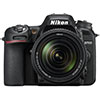
Nikon D7500: What you need to know The Nikon D7200 was, and still is, an extremely capable camera. So for Nikon to truly make its successor worth its salt, something other than a granular update was needed.
Fortunately, the new Nikon D7500 features enough improvements, including a lot of tech pulled from the APS-C flagship D500, that all signs point to it being the successor we'd hoped for.
After all, it uses the same 20. 9MP sensor with no optical low pass filter as the D500, as well as its Expeed 5 image processor. This new processor is 30% faster than the Expeed 4 processor in the D7200, a speed advantage that gives the D7500 a leg up in a few key areas like: burst speed, buffer depth, video capability and native ISO sensitivity.
Nikon D7500: What you need to know
Before we jump into tech specs, let's talk about the body of the D7500, because some minor changes should add up to an improved user experience, including a 3. 2” 922k-dot tilting touch LCD. Sure it's slightly lower resolution than the 1. 2M-dot LCD of the D7200, but the touch capabilities are a welcomed inclusion. They can be used for selecting an AF point in live view, or navigating the camera menus.
The D7500 is also 35 g / 1. 2 oz lighter than its predecessor and its body is slightly more narrow. The slimmer body design results in a marginally deeper grip. Weather-sealing on the camera has also been beefed up over its predecessor, though the camera loses its second memory card slot.
Nikon D7500: What you need to know
The D7500 is now capable of 4K video capture in 30, 25 and 24p. Users can now also shoot 4K UHD timelapses. But don't expect your lenses to offer the same field of view when shooting video as they do for stills, because like the D500, the camera uses a 1. 5x crop of the sensor when capturing 4K (that's a total crop factor of 2. 25x relative to full-frame). Recording time is similarly cut off at 29:59.
That processing speed boost also translates to an increased burst rate of 8 fps (up from 6 fps on the D7200) with a buffer depth of 50 14-bit Raw files or 100+ full-size JPEGs. The ISO range is 100-51,200, and expandable from ISO 50 to 1. 6M – the same as the D500.
Nikon D7500: What you need to know
When shooting in movie mode, users can make use of both Auto ISO as well as power aperture to maintain exposure in a smooth manner. The camera also features helpful video tools like a flat picture profile (similar to log gamma) and zebras. In addition to 4K it can also shoot Full HD in 60p down to 24p, with no additional crop. And when in HD capture there is an electronic VR option to help stabilize footage. Users can also use Nikon's Active D-Lighting (in HD only).
Nikon D7500: What you need to know
Other gains from the D500 includes its 180k-pixel RGB metering sensor for more accurate focus tracking and metering. The D7500 also now offers Nikon's much-loved highlight-weighted metering mode.
Not everything is borrowed from its big brother though: The D7500 uses the same 51-point AF system with 15 cross-type points as its predecessor, as opposed to the 153-point AF module found in the D500. That means more potential for hunting in challenging light with off-center points. It also does not support UHS II media, like the D500.
Nikon D7500: What you need to know
Despite using the same AF system as the D7200, there are important improvements to the overall AF experience. For instance the camera gains the D5/D500's ability to fine-tune lens precision using Live View, thanks to 'Auto AF Fine Tune'.
And the updated 180k-pixel RGB metering sensor should allow for very precise subject (including face) recognition and tracking to maintain focus on subjects that move, even erratically, around the frame. Additionally, the camera gains Nikon's group area AF mode.
Nikon D7500: What you need to know
Users can record 4K UHD directly to an external recorder via HDMI out, while also capturing compressed 4K to a memory card. The camera also offers a USB 2. 0, microphone, headphone and a remote control port.
The D7500 is also now compatible with Nikon's radio transmitters for flash control.
Nikon D7500: What you need to know
The viewfinder remains the same as its predecessor, offering . 94x magnification with nearly 100% coverage. Like the D500, the viewfinder uses an OLED info display for easy viewing.
The camera's shutter is rated for 150k shots and now features a shutter monitor, which automatically adjust shutter speeds to keep them accurate.
Nikon D7500: What you need to know
SnapBridge compatibility should come as no surprise in the D7500: it offers both Wi-Fi and Bluetooth connectivity for transmitting images and shooting remotely. However NFC has been removed. Speaking of transmitting images, the D7500 now offers an in-camera batch Raw processing option.
Nikon D7500: What you need to know
There is also a new Multiple Exposure mode that combines 10 images into one (but saves each of the 10 images individually as well). As well as a new Auto Picture Control function that analyzes the scene to provide a pleasing tone curve.
Other improvements come in the form of a new battery, the EN-EL15a, which apparently manages power better than previous EN-EL15 batteries. Fortunately it is both backward and forward compatible. Less fortunate: the D7500 offers lower battery life than the D7200: CIPA rated 950 shots per charge vs 1110.
Nikon D7500: What you need to know
The Nikon D7500 will be available this coming summer for a body-only price of $1250 and a kitted with the Nikkor 12-140mm F3. 5-5. 6 ED VR for $1750.
. dpreview.com2017-4-12 07:00

